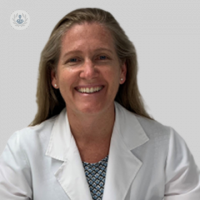Fibroids: An in-depth guide
Written by:Fibroids are very common, non-cancerous growths that form in the uterus. In her latest article, highly-renowned consultant gynaecologist and obstetrician Ms Andrea Day explains this common condition in detail, including the causes, signs and treatment of fibroids.
What are fibroids and what causes them?
Fibroids are benign (noncancerous) tumours that grow in the uterus (womb). They are made up of muscle and fibrous tissue and can vary in size from small and undetectable to large and noticeable. The exact cause of fibroids is unknown, but several factors may increase the risk of developing them, including ethnicity and genetics, and some hormonal changes. Fibroids are most common in women of childbearing age, but they can occur at any age and tend to shrink after the menopause.

What are the signs that women need to look for to suspect they have fibroids?
A third of the population has fibroids, however, most women aren’t aware they have them, as they are often asymptomatic. However, fibroids can cause a variety of symptoms in some people, depending on their size and location.
- If they are close and stretch the lining of the womb, they can cause heavy or prolonged periods
- if they are close to the bladder or the ureters (tubes that take the urine from the kidney to the bladder, they can cause pressure symptoms such as frequent urination or difficulty emptying the bladder. If they are at the back of the womb and quite low, they can cause lower back pain and very rarely constipation or rectal pressure.
- Large fibroids occasionally can cause discomfort and sometimes can cause pain during sexual intercourse
- There is no clear evidence they cause Infertility or miscarriage, but sometimes removing them is recommended. This is considered on a case-to-case basis.
Are fibroids serious?
In most cases, fibroids are not serious and do not cause any long-term health problems. However, in some women, it can cause symptoms that can affect their day-to-day routine and in pregnancy, can increase the risk of complications. Very rarely they can be malignant, and this is difficult to diagnose or recognise on the scan. One of the signs of malignancy is when they grow very fast.

How are they treated?
Usually, no treatment is needed. However, if they cause any significant symptoms, then treatment should be considered. Options may include:
- Medications: Hormonal medications can help to shrink fibroids and reduce symptoms, and this is considered for a short period. This is also considered prior to surgery in some cases.
- Uterine artery embolization (UAE): This is a minimally invasive procedure in which the blood supply to the fibroids is blocked, causing them to shrink.
- TCRF (transcervical resection of fibroids): surgery is done using a small camera that goes through the neck of the womb. A loop is attached which removes fibroids that may be protruding from the womb.
- For fibroids that are more within the muscle, myomectomy can be considered. This is a surgical procedure in which the fibroids are removed through keyhole surgery or with a bigger cut in the tummy. It is not a surgery which I would recommend unless it is considered necessary due to the risk of complications during and after the procedure.
- Hysterectomy (removing the womb) is only done in very severe cases with individualised care and multidisciplinary team discussion.
If you have fibroids, it is important to discuss treatment options with a healthcare provider to determine the best course of action.
Ms Andrea Day is a leading consultant gynaecologist and obstetrician, with over 20 years of experience. If you would like to book a consultation with Ms Day, you can do so today via her Top Doctors profile.



